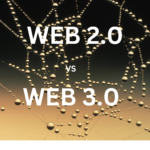As a Nigerian developer, you must be well accustomed to the terms “Web 2.0” and “Web 3.0” if you follow up with the Technology industry and trends.
The internet as we know it went through numerous stages before it got to this point, and internet users engage with it differently in Web 2.0 and Web 3.0 versions of online services.
As a result, developers worldwide, especially Nigerian developers, are willing to learn the latest skills required to meet this advancement in the Tech sector.
Since its early stages, the internet has gone through many stages of development. We had Web 1.0, which comprised static web pages that served content from the server’s file system. Web 1.0 made it easy for internet users to obtain information practically globally.
However, Web 1.0 did not have any features for interacting with the material.
Consequently, web 2.0 began to gain popularity, and the following uncovering of flaws in web 2.0 resulted in the creation of web 3.0. So before we dive into their differences, what are Web 2 and 3 all about?
Table of Contents
What is Web 2?
Web 2 is the most recent version of the internet, less static and more dynamic. Its underlying technology tries to engage people actively, and the material is increasingly user-generated. Web 2 components such as blogs, wikis, and social media platforms have altered how we exchange and present information.
Web 2.0 provides free information sorting, allowing users to obtain and categorize information.
Furthermore, the second generation of internet services emphasizes dynamic content with excellent responses to user inputs.
What is Web 3?
Web 3 is the Internet of the future, a more intelligent, autonomous, and open version. Computers will be able to understand the information in a more human-like manner, and consumers will be provided with more tailored content and experiences via the usage of technologies such as Blockchain, Augmented Reality (AR), Artificial Intelligence (AI), and Virtual Reality (VR).
Web 3.0 uses artificial intelligence to get accurate results more quickly while providing access to real-time insights. Web 3.0 also allows users to use the power of 3D visualizations and graphics.
Now let us connect the dots between these three tech developments; web 1.0 was primarily static and focused on giving information. The web became more dynamic and social with Web 2.0. Web 3.0 will make the web more intelligent and spread more.
Now, let’s talk about the key differences between Web 2 and Web 3 that any Nigerian developer should be aware of in the following criterion:
Differences Between Web 2 and Web 3
-
Technologies
Web 2.0’s impact has considerably benefited several breakthrough technologies. Web 2.0 Layout technologies allow greater dynamic control than Web 1.0.
Two of the key programming languages advancing web 2.0’s development are AJAX and JavaScript. And as a Nigerian Developer, you should also know about the dominance of CSS3 and HTML5 in Web 2.0.
Another difference between Web 2 and Web 3, on the other hand, is that the latter helped to introduce new technologies. AI, semantic web, and decentralized protocols are just a few significant technologies that will power web 3.0.
Knowledge bases and ontologies are two more key technologies impacting web 3.0 development. Also, this gives the new rise to the need to know these technologies as a Nigerian developer looking forward to moving into Web 3.0.
This criterion is also one of the differences between Web 2.0 and Web 3.0 that are peculiar to Nigerian developers.
Read also: The pros and cons of 5G Technology.
-
Type of application
Web 2.0 is characterized by web apps. Web 2.0 applications include two-way websites, video websites, podcasts, and individual blogs.
These apps are also based on the average developing skills of a typical developer like Typescript, Javascript, HTML, CSS, Bootstrap, and others.
Web 3.0, on the other hand, encourages the development of smart apps by enabling them to use Machine Language (ML) and Artificial Intelligence (AI) characteristics.
Multi-user virtual worlds, 3D portals, and integrated games are some famous examples of web 3.0 applications.
Join Insight.ng’s Whatsapp community to connect with other professionals in the Tech industry.
-
Principle of content storage
With Web 2.0, the network gained responsibility for storing information, causing special access issues as well as concerns about the safety and security of online data.
Computers in Web 2.0 employ HTTP as unique web addresses to locate information stored in a fixed place, often on a single server.
Meanwhile, on Web 3, with the flexibility of data interchange, which may now exist at several sites, Web 3.0 has reduced the risk of losing personal information online.
However, since information will be discovered based on its content in Web 3.0, it may be kept in several locations simultaneously, making it decentralized; unlike Web 2, this is not in the interests of the internet giants.
However, in terms of data transmission speed, Web 2.0 transfers outperform Web 3.0.
-
Program categories
The applications that go with each would be a critical factor in explaining this Web 2 vs. Web 3. The difference between Web 2 and Web 3 in this criteria is that web 3.0 is a driving force behind the development of intelligent applications that use machine learning and artificial intelligence (AI).
Web 3.0 applications include multi-user virtual worlds, 3D portals, and integrated gaming, while Web 2.0 encompasses web-based applications, including video websites, two-way web pages, podcasts, and personal blogs.
-
Focus and purpose
Differences between Web 2 and Web 3 can be explained using their purpose and what they are focused on as a criterion.
The goal of Web 2.0 was to make the Internet more interactive for users and was all about bringing people together and creating communities.
To begin with, Web 3.0 altered this by introducing substantial interactivity, allowing individuals to add to online information without technical skills. They may also do additional interactions such as searching, filtering results, entering data, etc.
Web 3.0 encourages people to become active creators of online content. The goal of web 3.0 is to integrate information and give individuals greater control over their digital life. Web 3.0’s executable phase will employ AI and ML to generate automated, tailored, and interoperable consumer experiences, including real-time data monitoring, tracking, and immersion.
Read also: The future of IoT (internet of things).
Conclusion
The discussed differences between Web 2 and Web 3 show that web 3.0 has more incredible benefits than web 2.0. Most significantly, web 3.0 offers users a more secure, trustworthy, and private environment.
This infrastructure looks to be highly promising for facilitating human-machine communication. Others have referred to decentralized web 3.0 as the “decentralized web.”
So as a Nigerian developer, you should be looking forward to introducing these new techs into the Tech sector and be ready to learn about them. However, online 2.0 remains the joint base for many of the web applications we use today, so Web 3.0 will take time before it completely dominates the technology industry.
Subscribe to our newsletter to receive updates of our latest posts on Tech.
About Author
- Emmanuel Odebiyi is a seasoned content writer who specializes in writing valuable and engaging content in the technology, career, freelancing, finance, and lifestyle niches. He also writes sales copies that turn visitors into returning customers.
Latest entries
 EntrepreneurDecember 27, 2023Writing Business Proposals: Content of an Effective Business Proposal
EntrepreneurDecember 27, 2023Writing Business Proposals: Content of an Effective Business Proposal CareerDecember 20, 2023How to Publish Your Book on Amazon: A Guide for Nigerians
CareerDecember 20, 2023How to Publish Your Book on Amazon: A Guide for Nigerians EntrepreneurDecember 11, 2023Top 6 Analytics Tools To Track Your Business Growth
EntrepreneurDecember 11, 2023Top 6 Analytics Tools To Track Your Business Growth TechnologyNovember 26, 20235 Major Differences Between Web 2 and Web 3 Every Nigerian Developer Should Know
TechnologyNovember 26, 20235 Major Differences Between Web 2 and Web 3 Every Nigerian Developer Should Know

